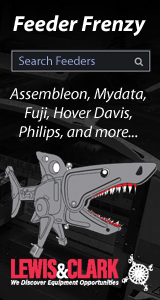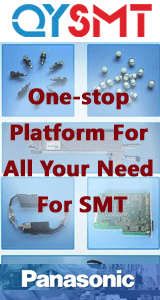Printed Circuit Board Assembly & PCB Design Forum
SMT electronics assembly manufacturing forum.
- SMTnet
- »
- Electronics Forum
- »
- IONIC CLEANLINESS SPEC FOR BARE PWBs
IONIC CLEANLINESS SPEC FOR BARE PWBs
![]() HI
can anyone tell me if they ask there board houses to h...
- Dec 05, 2002
by
Casimir Budzinski
HI
can anyone tell me if they ask there board houses to h...
- Dec 05, 2002
by
Casimir Budzinski
![]()
![]()
![]() It is an interesting topic. This will tell you if they are ...
- Dec 05, 2002
by
It is an interesting topic. This will tell you if they are ...
- Dec 05, 2002
by
![]()
![]() Hi,
Is the limit for " 10.07 " for assemblies ? I guess ...
- Dec 05, 2002
by
Kris
Hi,
Is the limit for " 10.07 " for assemblies ? I guess ...
- Dec 05, 2002
by
Kris
![]()
![]()
![]() While J-STD-001 specifies an upper limit for acceptance of a...
- Dec 05, 2002
by
davef
While J-STD-001 specifies an upper limit for acceptance of a...
- Dec 05, 2002
by
davef
![]()
![]()
![]() Bare board cleanliness is still primarily measured by resist...
- Dec 06, 2002
by
davef
Bare board cleanliness is still primarily measured by resist...
- Dec 06, 2002
by
davef
![]()
![]()
![]() Military and most commercial standards requires post-soldere...
- Dec 06, 2002
by
Military and most commercial standards requires post-soldere...
- Dec 06, 2002
by
![]()
![]()
![]() Hi
Well you already got good answers with some diversity,...
- Dec 09, 2002
by
Hi
Well you already got good answers with some diversity,...
- Dec 09, 2002
by
![]()
![]()
![]() I have seen the 6.5 ug/sqin and we have a fab house using 6....
- Dec 09, 2002
by
I have seen the 6.5 ug/sqin and we have a fab house using 6....
- Dec 09, 2002
by
![]()
![]() Mike wrote : "Personally, I would not accept an incoming boa...
- Dec 09, 2002
by
Kris
Mike wrote : "Personally, I would not accept an incoming boa...
- Dec 09, 2002
by
Kris
![]()
![]()
![]() Hi
I kind of agree without any reliability studies.
Wh...
- Dec 09, 2002
by
Hi
I kind of agree without any reliability studies.
Wh...
- Dec 09, 2002
by
![]()
![]()
![]() The EMPF has published a paper/ study on this topic, one of ...
- Dec 10, 2002
by
CAL
The EMPF has published a paper/ study on this topic, one of ...
- Dec 10, 2002
by
CAL
![]()
![]()
![]() From personal experience, if the PWB vendor is cutting costs...
- Dec 10, 2002
by
From personal experience, if the PWB vendor is cutting costs...
- Dec 10, 2002
by
![]()
![]() Hi Mike
Why is there a difference in readings on the Ome...
- Dec 12, 2002
by
Kris
Hi Mike
Why is there a difference in readings on the Ome...
- Dec 12, 2002
by
Kris
![]()
![]()
![]() Hi
I am wondering about your reply,
Please continue.
...
- Dec 12, 2002
by
Hi
I am wondering about your reply,
Please continue.
...
- Dec 12, 2002
by
![]()
![]()
![]() > Military and most commercial standards requires
> ...
- May 09, 2004
by
> Military and most commercial standards requires
> ...
- May 09, 2004
by
![]()
![]() Yes
These instruments are intended for process control. ...
- May 10, 2004
by
davef
Yes
These instruments are intended for process control. ...
- May 10, 2004
by
davef
![]()
![]()
![]() Many Tnks Dave, always helpful is your support.
I am not ...
- May 10, 2004
by
Many Tnks Dave, always helpful is your support.
I am not ...
- May 10, 2004
by
![]()
![]()
![]() Hi Gabriele
Has the snow melted up there, yet?
No, SMT...
- May 10, 2004
by
davef
Hi Gabriele
Has the snow melted up there, yet?
No, SMT...
- May 10, 2004
by
davef
![]()
![]()
![]() Hi Dave,
I've got it, many thanks.
Snow ?
...
- May 12, 2004
by
Hi Dave,
I've got it, many thanks.
Snow ?
...
- May 12, 2004
by
![]()
![]()
![]() I'd like to follow the thread discussed on assembly. Hope E...
- May 18, 2004
by
I'd like to follow the thread discussed on assembly. Hope E...
- May 18, 2004
by
![]()
![]() Ionic cleanliness is pretty much meaningless, when discussin...
- May 18, 2004
by
davef
Ionic cleanliness is pretty much meaningless, when discussin...
- May 18, 2004
by
davef
![]()
- SMTnet
- »
- Electronics Forum
- »
- IONIC CLEANLINESS SPEC FOR BARE PWBs








